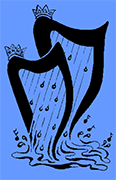Stories
Welcome to our stories page! Here you will find photos and articles about various subjects of interest to harp players and the general public. If you have a photo or article you would like to see printed here, please contact info@reigningharps.com for submission guidelines.
Note: photos and stories on this page are reprinted with the permission of the photographers and authors, who retain all other rights. Please do not reproduce by any means without the written permission of the original photographer or author. Thank you.
Harp Spectrum History by Joyce Rice
A Tour of Ancient Harps in Dublin by Peter Barry
In Which Your Editor Leaves Her Comfort Zone by Diane Moss
A Sleeping Beauty Awakens by Peter Barry
Harp to Hawaii by Diana Beaumont
And There Will Be Goats by Shawnmarie Stanton
Harp Spectrum History
By Joyce Rice (October 2023)
Harp Spectrum had its genesis when the late Patricia Jaeger and I were having a cup of tea one October Sunday afternoon in 1999. She had several harp and string students (she was both a harpist and violinist), and wished she had a device that her students could use and learn from while waiting for their siblings to finish their lessons. She had exercises in rhythm, sight-reading, etc. in mind, but over the next 90 minutes we expanded to something that would teach them more about the history of the harp and its music. We imagined that it would be in the form of a CD. We thought we needed help from more harpists, so we contacted several others in the Seattle area to form a committee in early 2000.
We needed a name, and the late cross-strung harpist and committee member Harper Tasche Jordan came up with “Harp Spectrum” – perfect, we said!
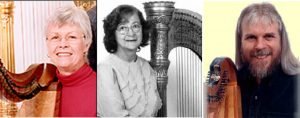
Founding members Joyce Rice, Patricia Jaeger, and Harper Tasche
The committee thought we could also get videos made, too, of harp history, playing styles, etc. to better inform music educators, students, and the general public. I have in my files a Strategic Plan that someone wrote up for us. Among the details is the startling figure of $12,000 – $100,000 cost for two 45-minute videos. Obviously we would need a videographer and a pile of money!! (We eventually dropped the idea.)
Then someone knew a fellow in the recording business and invited him to talk to us, and he completely upended our idea of a CD. “What you really should have is a website,” he said, that you can add to, correct, etc., which you can’t with a CD. Videos can be on the website, too.” Websites were new to us all in 2000 but we were quick to hop on board.
That meant we needed a webmaster. As luck would have it, Harper Tasche happened to be on a flight seated next to a young Seattle woman named Deb Seymour who was working on developing websites! She said she thought a class at North Seattle College would like to take us on as a project, which they did. After they completed their design, Deb took over as webmaster and continued for several years. She was succeeded for a while by Colin May and Jason Wood.
I had been a pedal harpist since childhood, had taught students on lever harp, and had attended conferences on historical as well as folk and pedal harp, so I was acquainted with several harpists of different “persuasions”. I wrote to many of them and several replied. Soon we had a core of nine articles to get us started. (Over the years a few also contributed their videos.)
Some of us appeared in fund-raising concerts over the next year and a half to pay our fees. We had business cards and promotional pencils made, and a wonderful huge poster that we took to the first harp conference to take place after we had our opening articles up and running.
Then in 2002 I moved to Hermiston, OR, the committee dissolved, and I became the manager, solicitor of and writer of articles, and added an annual list of summer harp camps. A few donors kept us solvent. I’m now back in Seattle. For many recent years Bob Zawalich has been my patient and forgiving webmaster. Everyone has worked without pay. There are now 44 articles and many links to builders, composers, etc.
By 2022 I decided it was time to pass the torch and we posted an announcement to that effect. Ottawa-based harpist and web developer! Hannah Warren stepped up, saying “the site was a valuable resource for me when I first started learning the harp, and one that I think the harp community definitely needs as it continues to grow! I look forward to watching it grow and continuing the Harp Spectrum legacy.” So do I!
www.harpspectrum.org will still be the website location. People can get in touch with Hannah at hannah@harpspectrum.org, or at her website, https://hannahplaysharp.com. She says that she would like to add more harpist-crowd-sourced information to the site. I look forward to reading the Harp Spectrum of the future!
A Tour of Ancient Harps in Dublin
By Peter Berry
At the end of March I had the great blessing of going on a private tour of ancient harps “behind the scenes” in museums in Dublin. The tour was led by Simon Chadwick, a renowned expert in early Gaelic harps (see http://www.earlygaelicharp.info/). On the tour was a dear friend of mine in Dublin who plays the harp, her Mom, her harp teacher, a friend of Simon’s researching for a biography of the harper Patrick Quin, and myself.
We began in a private room at Trinity College Library where we had 45 minutes alone with the exquisite “Castle Otway Harp”. It is signed and dated by its maker “Cormack O’Kelly, 1707”. It was played at the Belfast Harp Festival in 1792 by Patrick Quin. It was thrilling to be in the presence of this beautiful harp. Looking closely, one can see that it had been elaborately painted, but it is still a gem in its current state.
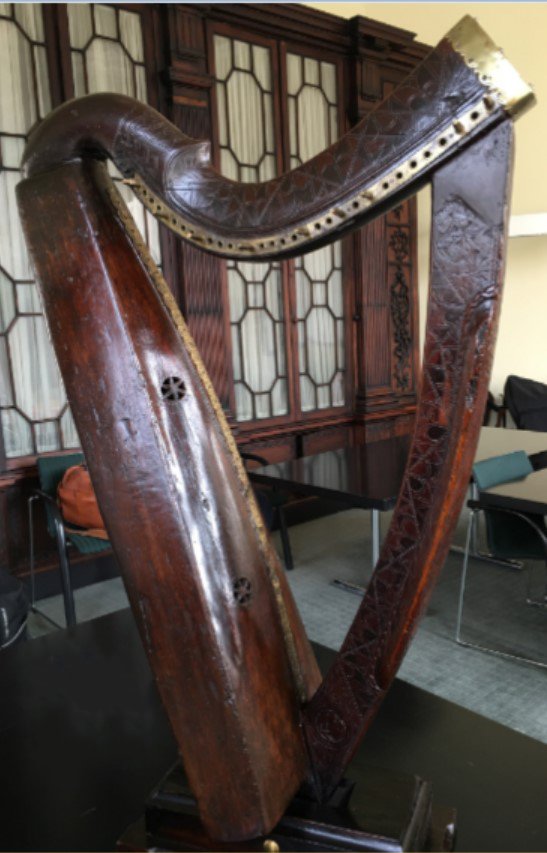
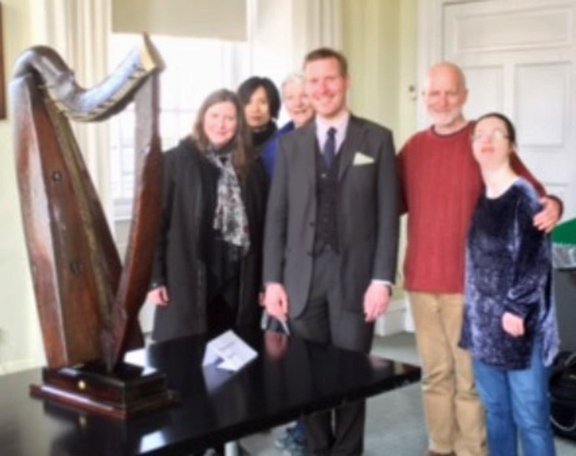
From this private room we entered into the back of the “Long Room” in the Trinity College Library where we joined throngs of people to see the famous Trinity College Harp, estimated to be 600 years old. This is the harp that is the National Symbol of Ireland. It was ancient when it was played in the streets of Limerick in the 1700s by Arthur Ó Néill, one of the last of the old Irish harpers in the 18th century.
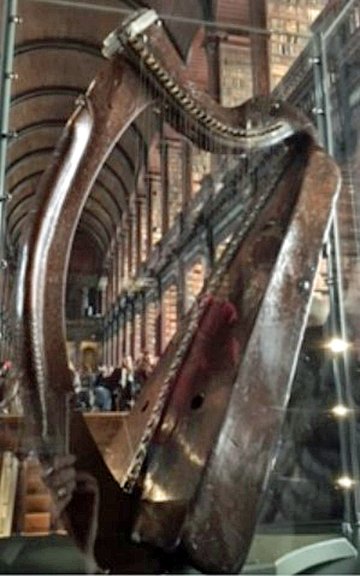
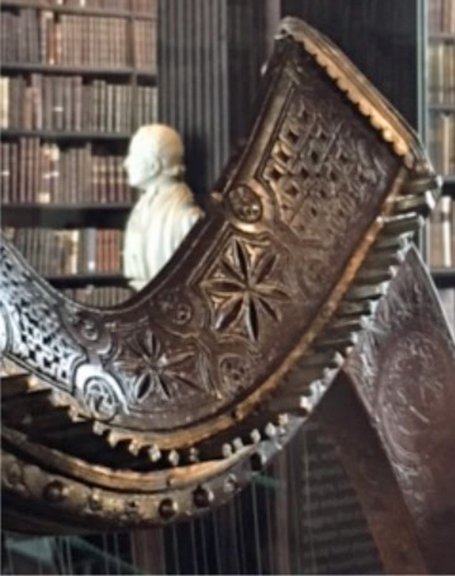
From the library we went to the National Museum where we saw the Ballinderry harp fragments and depictions of harps on various relics and shrines from medieval times. Afterwards, we had the privilege of going into the storage rooms of the museum to see nine harps not on display for the public.
One of these was the Cloyne harp, signed and dated 1621 by its maker Donnchadh Fitz Teigh. Only the neck and forepillar of the harp remain, but in 1996 a replica of the harp was made. Chemical analysis of pigments barely visibile on the harp fragments allowed the replica to be painted as it may have originally appeared. It is stunning! It bears the inscription “I am the Queen of Harps” in Latin, near a bust and head of a Queen at the top of the harp.
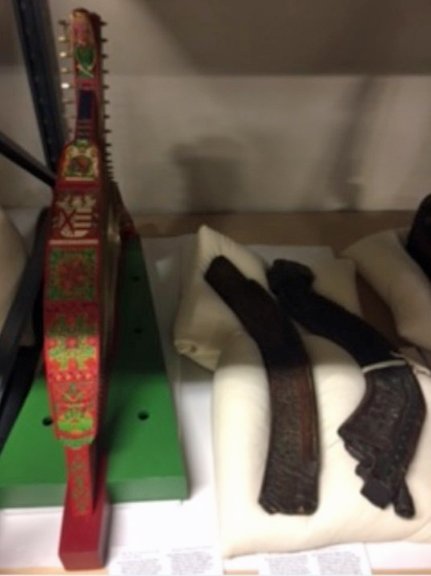
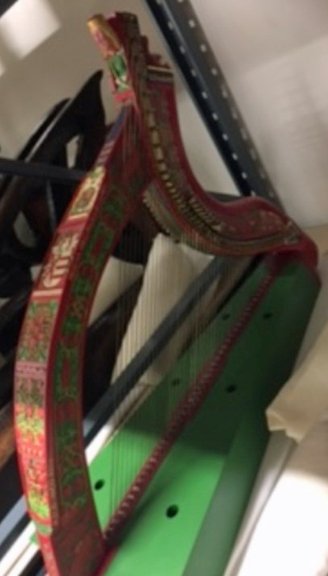
Our final stop was the Guiness Storehouse where we saw the Downhill harp, made by the same Cormack O’Kelly who made the Otway harp, but this one was made five years earlier in 1702. It was amazing to see the difference five years made in the skill of the harp maker. It was played at the Belfast Harp Festival in 1792 by Denis O’Hampsey, the only harper at the Festival to play in the ancient style with shaped fingernails. O’Hampsey died at the age of 112 and was alive in the 1600s, 1700s, and 1800s and is a fascinating harper to contemplate, and the tunes he played were from the mists of time. To be in the presence of his harp was an inspiring privilege.
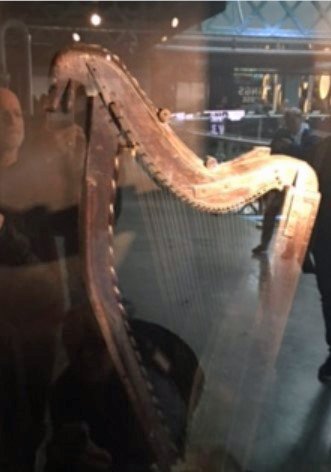
In Which Your Editor Leaves Her Comfort Zone
By Diane Moss (January 2015)
A couple of years back, Seattle harp player Carol Levin sent me a note for Reigning Harps, a little announcement about how she had played and appeared in a YouTube compilation made by the Dr Who Fan Orchestra. (The DWFO, led by Stephen Willis, was the first “virtual orchestra” on YouTube that compiled recordings made by musicians from all over the world into one whole. You can learn more about them at http://doctorwhofanorchestra.blogspot.com/.)
As a big nerdy Dr Who fan myself, I wrote back to congratulate her and a correspondence followed in which Carol encouraged me to “try out” for the next compilation. The harp parts are written for pedal harp, but she was managing well on her lever harp and thought I could do so as well. The next DWFO piece filled up before I applied (they cap applications at 500 and usually fill in one or two days!). However I was ready for the one after that, and after filling out the required forms, learned that I was “in” for compilation #9, “Martha Meets Shakespeare”.
This was very exciting, and I waited happily for my part to arrive. And then it did, and reality set in. What was I thinking? The part was not difficult… in fact, much of it was one hand at a time. But that’s where the easy stuff ended and mild panic ensued!
Let me set the scene… I am primarily a “folky” player. I can read music, but I prefer to play by ear. I’m not the most coordinated harp player that ever was, and I enjoy traditional music where I can “wing it” a bit, improvising here and there when I go astray, employing a rubato style rather than metronome-strict renditions. I like to play in groups, but tend toward harp circle or session playing where everyone plays an individual version of a tune, adding texture and depth through variation. I rarely play in flat keys, so keep my harp tuned in C. I play a few tunes that require lever flips, but I often rearrange tunes to imply accidentals rather than actually play them. I prefer not to have a music stand or printed music in front of me… just me and my harp and the tune in my head.
But now, I had signed up to play a harp part that came complete with its own “click track”… a computer playback of the part, with incessant unforgiving metronome. I needed to learn it EXACTLY as written and EXACTLY at tempo so my part would match the hundreds of other submissions. This meant I needed to learn how to play with earphones stuck to my head and a computer plus a written score at my side. Never mind that the part (in five movements) required a number of key changes and as many as four flats! Oh, and did I mention the glisses? My folky self had never really glissed, except as a joke, but this was no laughing matter!
My first job… retune my harp from C to Ab, with all the extra tuning required to get that stable. Then, read through the part very very slowly, noting that it exceeded the range of my 36-string harp in a couple of places. Fortunately, the notes I didn’t have in the bass were doubled an octave above, so I could at least play those. And the notes I didn’t have in the treble I produced by retuning my top three notes (my highest C to a necessary D, my highest B to C and then levered up to get a necessary Db, and my highest A levered up for a necessary Bb… this meant missing a note in the scale here and there, but they weren’t needed except in the glisses and I’d at least have the proper ending and beginning gliss tones.) Next, I marked in all the lever flips (my teacher Harper Tasche was a big help with this)… there was no time at the key changes to flip all necessary levers, so the job was to work backwards from each key change to find an appropriate moment to change individual levers up and down and back again, working from C to Ab to Eb to F and back to Ab over the course of 7 minutes. Then, I had to buckle down and learn to gliss properly, in all directions. My thumb and first finger developed sore calluses from zipping up and down the strings, and I realized that rather than the dreamy arm-waving that I had imagined, glissandi have duration and rhythm and accents of their own… some of those in the final movement of this piece were very aggressive, true attack-glisses!
Finally, nothing for it but to practice. It was one thing to get used to playing with one earphone in so I could hear the click track and my harp at the same time, and a cord going from my head to my computer where I could see an oscillating soundtrack of the harp part going by, all this while I was reading from a score which I had taped together to minimize page turns. It was another thing to find that I could not practice up to tempo with all those lever changes, yet I needed the click track to get my entrances timed correctly and my sense of how my part fit into the whole. Enter Transcribe, a program I purchased which allows you to slow down a recording without changing its pitch. For a week I practiced my part at 50% speed, then increased it by 10% a week until I was able to play along at the correct tempo, lever flips and all.
Finally, with the submission deadline approaching, I felt ready to try a practice recording. Fortunately my husband has a digital recorder, and we have a nice quiet back room where I could shut myself in and record take after take after take. Never have I been so aware of dogs barking outside, or jets passing overhead, or heaven forbid the phone should ring… any of those would scrap a take, no matter how well I was playing. Of course I had to change levers quietly, turn pages silently, and avoid tapping my foot. But the most embarrassing part was realizing how often I talk out loud (sometimes not very nice words) while I play. I honestly thought I might have to tape my mouth shut!
My first attempts at recording were far too “live”… the reverb from my harp was extreme. Again, with the help of Harper Tasche, who willingly crawled all over the floor taping “marks” for microphone and harp placement on a rug, an appropriate balance was found and recording began in earnest. After three or four days I had an mp3 recording to submit, via DropBox due to size, which was the best I felt I could do. All the notes were there, though I was painfully aware of one place where my finger slipped off a string and twanged a little, and another place where I had a nano-hesitation in a fast rhythmic part. But I figured the sound engineer could erase me if necessary, so I hit SEND and celebrated for a few hours…
Until I started another project! Originally, I had thought if I could just submit the audio recording, I wasn’t even going to worry about doing a video. But I still had some time, and with the audio gone, the video suddenly seemed like it would be easy… it’s basically “lip synched” as no sound from the videos would be used. I raided my closet for anything I could find that looked slightly Elizabethan, and found a mob-cap type bonnet and a chemise-style gauzy blouse… good enough! It was actually fun to just play along by memory to the click track while my husband shot a video, no headphones or music stand required. And to ensure a nice relaxed looking playing style, we only shot the middle slow section, without any key changes. I figured the fast parts with all the glisses could be demonstrated by the pedal harpists.
Months later, the finished video appeared on YouTube (https://www.youtube.com/watch?v=g3uPy1hB_iY), and I was thrilled to see that I had made the cut… despite being dressed like a poor washerwoman in her nightie, there are two nice video clips of me playing, one at 3:20 and one at 5:12. Carol Levin, who got me started on this crazy voyage, appears at :55 and at 1:26 in a stylish chapeau. I owe her thanks for all her encouragement and good hints. It was out of my comfort zone, for sure, but a great musical “stretch”!
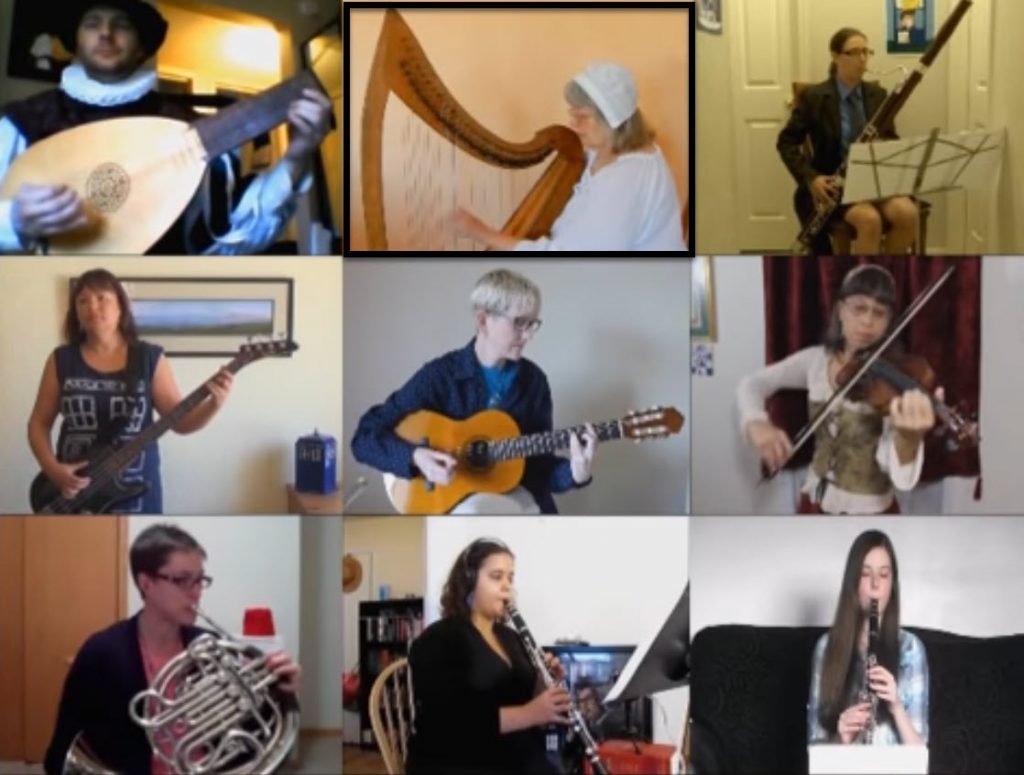
(Oh… and the day after I finished? I tuned my harp back to C!)
A Sleeping Beauty Awakens
By Peter Barry
I have a new treasure in my life, and a special one.
Here’s the background… I went to Ireland in 1992 for the first (of many!!) trips and met with a man who made replicas of medieval Irish harps, the most authentic replicas I’ve ever seen or heard of. The soundboxes were carved from a single block of willow, and the soundbox then was sealed at the one open side with a soundboard of bog pine, estimated to be between 5 and 11 thousand years old! The combination of the one-piece soundbox and bogwood soundboard, and high tension brass strings, are what gives his harps a clear resonant bell-like tone, bringing back the ancient sound of the early Gaelic harp in our time. At the time I contracted with him to make my harp, he said it would take a year and I’d have to return to Ireland to get it because he had had a bad experience shipping a harp to America and wouldn’t risk it again.The one he had a bad experience with was shipped from Ireland to America by boat in 1991 and was stored temporarily in a customs warehouse in Norfolk VA in the August heat and humidity. I don’t know how long it was in the warehouse before it got to its owner in NC, but it had been heat-damaged and she found it to be unstable and couldn’t keep it in tune. She was a novice harper, and it was a sophisticated harp to begin with, and she was overwhelmed by the challenge. Frustrated, she put it back in its case and didn’t touch it for over two decades!
I remembered the harpmaker saying one of his harps went to NC, so this winter I asked him for the name of the person who bought it, and through the wonders of the internet found her phone number and called her in January. We began a pen pal correspondence and I offered to buy the harp from her if I deemed it could made to be playable.
When I first laid eyes on the harp on a trip to Carolina at the end of April and held it, I carefully scrutinized it, and found a couple of places where there was evidence of the forepillar having shifted. However, I saw nothing so drastic as to dissuade me from buying the harp and bringing it home to Seattle. In the meanwhile, for the previous month of April, she had followed directions we had both recently received from the harpmaker, and she was able to get it stabilized and to stay in tune.

In the first weeks after bringing it home, I consulted with the harpmaker in Ireland and an expert on early Gaelic harps in Scotland, and ordered a complete set of strings to replace the strings on the harp. The combination of metallurgical expertise and early Gaelic harp expertise of Simon Chadwick in Scotland has been invaluable!
The lowest 8 strings in the bass are sterling silver, and I put the last of those last silver strings on the harp in rhythm with the Full Moon in June. Silver moonlight magic!
I call this harp Aisling, an Irish word sometimes used for a woman’s name (pronounced ASH-ling). It means dream or vision. She’s been in her case silently dreaming of making music for a very long time! Soon that dream will come true for her. I’m playing all three of my harps in a concert on Sept 13th at East West Books. This will be the first time this harp, more than two decades old, has EVER been played in a public concert. We’re both excited!
Harp to Hawaii
By Diana Beaumont
I didn’t tell many people that I wanted to take my 34-string Dusty Strings harp with me on vacation to Hawaii because I was afraid it would seem frivolous or extravagant. But the truth of the matter is that I suffer from “harp separation anxiety” in much the same way that a toddler cries when separated from her mother. So I justified to myself that I needed my harp so I could practice for the small gig I was to play within days of my return home.
But how do we carry a full-size lever harp on the plane? Or should we ship it separately? How do we make sure the harp doesn’t get smashed or broken? How do we afford the cost and still expect to buy suntan lotion?
First we had to find a suitable protective cover. That was easy. “Dusty Strings makes harps and ships them all over the world,” I reasoned. “What do they do?” A phone call to Dusty Strings Interbay Workshop (206 634-1656) resolved that question. They make custom-built boxes of heavy-duty cardboard reinforced with struts and stays and hard foam braces. I could purchase one for a bit over $70. But no, they couldn’t ship my harp to Hawaii for me. I would need to do that myself.
We investigated FedEx and UPS only to learn that the cost would be in excess of $900. Perhaps we could ship the harp a few days ahead of our arrival by Alaska Airlines airfreight, since that’s the airline we had reserved. But no, we would need a special shippers’ license that would also involve some sort of advance security clearance. Alaska Airlines advised us, however, that we could check the box as excess baggage if it fit within certain size parameters. It did! And the cost? They quoted us $50.

The night before our departure I was nervous as I loosened the harp strings a turn and sealed the box with layers of heavy-duty strapping tape. The box already was printed with the words FRAGILE INSTRUMENT and THIS SIDE UP, but we added several photos of an actual harp as a visual cue to busy baggage handlers.
“I’m sorry, ma’am.” It was the curbside check-in guy running after me. “TSA wants you to open the box for inspection.” The TSA officer could clearly read my dismay, but she was unsympathetic. “You have to open it,” she insisted. “Well, I don’t have a box-cutter with me,” I replied, “so do you have some scissors?” As they began to hack indiscriminately at the box, I jumped into the fray and yelped, “No, no, no! Not like that! Don’t hurt my harp!” A small group of onlookers gathered. Probably against all TSA rules, I pointed out to them where to slice along the seam of the strapping tape. Then, seeing the large zippered instrument case inside the opened box, the TSA officer simply waved a piece of bomb-detection cloth over the top and ordered me to reseal the box again. Good thing I’d thought to bring the spool of strapping tape in my carry-on.
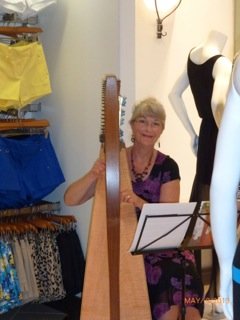
I chewed my lip when we arrived in Hawaii and my husband went off to fetch the box at oversize baggage claim. The balmy air and swaying palm trees did little to sooth my worry. Would the box have a huge dent in the side? Would my harp be in one piece? At last he appeared, a grin of relief on his face as he pushed my precious box through the throng of gawking travelers. It was intact!
That evening, having unpacked my harp at our rented condo, we took a walk to a nearby shopping center to clear our heads of travel weariness. I admired a pretty sundress in the window of a posh dress shop, and in a flash the sales clerks were all over me.
“Oh you must try it on! Here’s the flyer for our special event tomorrow evening! You must come!” Hot and tired, I just shook my head.
“So…will you have music at your event tomorrow night?” my husband wanted to know. “You don’t? Well, here’s a harpist for you!”
And that’s how I picked up my Hawaii gig…and a gorgeous sundress!
And There Will Be Goats
By Shawnmarie Stanton (June 2013)
When our friend, Nik Perleros, called and asked if my husband and I wanted to be in a music video he was directing for the Tea Cozies, we immediately said, “Yes!” Nik’s a very talented guy and fun to be around, so we knew it would be a great afternoon. He asked if I’d bring my Thormahlen Swan as well since he thought it would look great in the shot we were going to be in. I readily agreed because I love to show off my baby.
We showed up on the day of the shoot and walked through the set-up of the shot. Nik explained that I would be blindfolded and my husband would be behind me placing my hands on the harp. I would then pluck a few strings as my husband laid his head on my shoulder. Nik then said very casually, “Oh, and there’ll be some baby goats running around. We’re just waiting for them to get here.” I thought he was kidding. My husband, rightly, took him seriously. About 30 minutes later, we were in costume, the baby goats arrived, and we were shooting the scene. There were three goats, each with a person assigned to hold the goat until the fog machine was going and Nik called “Action.” Did I forget to mention the fog machine? So did Nik until right before we started shooting.
I sat at my harp, blindfolded, and listened to the chaos. Nik would make sure everyone was ready, then he’d tell the fog machine to go, then he’d say “action” and I’d feel my husband’s hands on mine, trying to place them somewhere on the harp strings that made sense, I’d begin attempting to pluck the strings in a manner that looked beautiful or the very least, interesting, and the goats would clomp around the stage, primarily gravitating toward me and trying to hide under my chair.
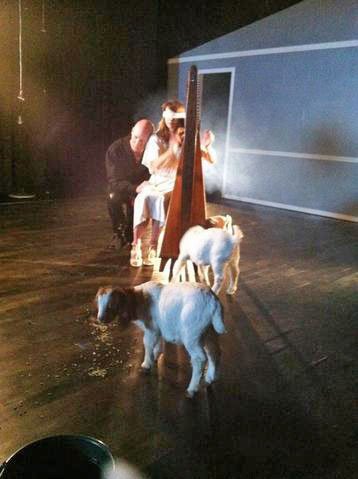
The only thing that kept me from completely freaking out about them possibly hurting my harp was the knowledge that my husband is even more protective of the Swan than I am. In any event, I can assure you that any sounds coming from my harp during this madness could hardly qualify as music. After about six or seven takes, Nik decided he had enough footage to work with. I was very relieved to take off that blindfold.
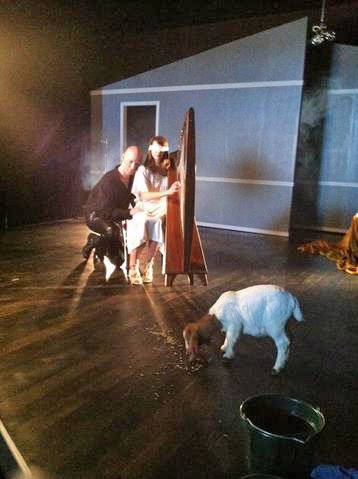
Nik then asked if we wanted to be in a few other shots. How could we refuse? If you watch the video, I’m the woman in the red lighting running in slow motion and my husband is the man with the hospital face mask on, sitting in a theater seat holding a baby goat. He’s also the man painted silver, lying on a hospital gurney with blood on his forehead, while a woman in red sequins (me) dances next to him. Now surely, those teasers must make you want to watch the video and listen to the Tea Cozies’ Cosmic Osmo.
[You can see the YouTube video at http://www.youtube.com/watch?v=QqN95PiX3DI, Shawnmarie and harp appear at 2:22.]
Photos: Performers are Shawnmarie and Roy Stanton, Harp from Thormahlen Harps, Baby Goats from Boise Creek Boer Goats.
